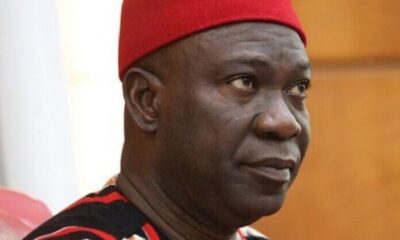Opinion
Navigating Inflation and Unemployment Shocks in Nigeria: Policy Pathways -By Prof. Jide Oladipo & Dr. Ejime Herbert Aniemeke
In Nigeria, the relationship between inflation and unemployment is shaped by supply-side bottlenecks, exchange rate volatility, and persistent structural weaknesses. Inflation is largely driven by cost-push factors, including high food prices, energy costs, and currency depreciation, rather than by demand pressures alone. Simultaneously, elevated unemployment levels are fueled by underdeveloped industrial sectors, a mismatch between education and labor market needs, and poor infrastructure. This dynamic creates a policy dilemma: traditional anti-inflation measures, such as higher interest rates, can stifle investment and job creation. As a result, relying solely on contractionary monetary policy risks deepening unemployment while failing to adequately curb inflation, a situation known as stagflation.

Introduction
Nigeria’s macroeconomic landscape has been severely tested by the dual shocks of soaring inflation and persistent unemployment. These challenges have been exacerbated by a mix of global and domestic factors: lingering COVID-19 pandemic effects, global supply chain disruptions, spillovers from the Russia-Ukraine war, and domestic policy misalignments.
Empirical evidence revealed that inflation in Nigeria is largely driven by cost-push factors – currency depreciation, high energy and food prices, insecurity, fuel subsidy removal, production and logistics bottlenecks. The Central Bank of Nigeria (CBN) has attempted to rein in inflation through monetary tightening, but structural inflationary pressures persist. Monetary measures alone have proven to be blunt instrument in tackling both inflation and unemployment, highlighting the need for coordinated policies that foster stability and long-term development.
On the employment front, joblessness, especially among youths and graduates, remains stubbornly high, despite official figures suggesting improvement. Revisions in data collection by the National Bureau of Statistics (NBS) have obscured the true scale of underemployment and informality. Job creation continues to lag behind population growth, exposing deep structural weaknesses in labour market policies, human capital development, and productivity. Youth unemployment exceeds 35%, with over 60% of the workforce engaged in informal activities.
This policy brief offers a macroeconomic review of these issues and proposes actionable recommendations for policy stabilization, rooted in global best practices yet tailored to Nigeria’s unique socio-economic realities.
- Inflation and Unemployment – Recent Trends
From 2020 through April 2025, Nigeria’s headline inflation followed a steady upward trajectory, well above the global benchmark of 2–3%. Starting at 13.25% in 2020, inflation rose consistently, reaching a peak of 33.24% in 2024 before easing slightly to 23.90% by April 2025.

Source: Authors’ compilation from NBS
Cursory Observation
Inflation rose from 13.25% in 2020 to 16.95% in 2021, driven by post-COVID supply disruptions, border closures, and soaring food and energy prices. In 2022, inflation accelerated to 18.85% due to naira depreciation and rising import costs. By 2023, monetary and fiscal imbalances pushed inflation further to 24.66%.
In 2024, inflation reached its highest level yet – 33.24% – fueled by the removal of fuel subsidies, exchange rate volatility, and persistent insecurity disrupting food supply chains. However, between January and April 2025, inflation moderated to 23.90%, likely reflecting base effects and some impact from modest policy tightening.
Unemployment data over this period has been relatively less transparent. A new methodology introduced by the NBS in 2023, aligning with International Labour Organization (ILO) standards, redefined employment as working at least one hour for pay or profit in the past week – compared to the previous 20-hour threshold. This methodological shift resulted in a sharp drop in reported unemployment rates, sparking debates over whether these figures accurately capture the reality of Nigeria’s labour market.
Unemployment Rate in Nigeria: 2020 – 2025 April
| Quarter | Unemployment Rate (%) | Methodology | Notes |
| Q4 2020 | 33.3 | Old | Highest recorded under the previous method. |
| 2021 | N/A | N/A | Transition from old to new methodology |
| 2022 | N/A | N/A | Transition from old to new methodology |
| Q1 2023 | 4.1 | New | First report using the revised methodology. |
| Q2 2023 | 4.2 | New | Slight increase from Q1 |
| Q3 2023 | 5.0 | New | Rise attributed to economic reforms. |
| Q1 2024 | 5.3 | New | Continued impact of subsidy removal and inflation. |
| Q2 2024 | 4.3 | New | Notable decrease from Q1. |
| Q3 2024 | 4.5 | New | Slight uptick due to seasonal employment changes. |
| Q4 2024 | 4.7 | New | Gradual increase towards year-end. |
| Q1 2025 | 4.9 | New | Early data indicating a modest rise. |
Source: Authors’ compilation from NBS reports
Unfortunately, these figures do not accurately capture the current situation, as they mask widespread underemployment, informality, and significant regional disparities in the labour market. The apparent improvement in the data does not reflect better job quality or higher productivity.
- Some Policy Challenges
- Monetary-Fiscal Policy Mismatch
Uncoordinated policies – tight monetary conditions alongside expansionary fiscal spending – have hindered macroeconomic stabilization. - Exchange Rate Instability
The sharp depreciation of the naira has intensified imported inflation and weakened investor confidence.
iii. Fiscal Pressures and Rising Deficits
Mounting debt servicing costs, coupled with the removal of subsidies without adequate compensatory measures, have eroded household welfare.
- Labour Market Mismatches
A disconnect between education outcomes and labour market demands limits the ability of youths to find formal employment. - Weak Structural Foundations
Deficiencies in infrastructure, power supply, logistics, and financial inclusion continue to constrain economic growth. - Insecurity
Widespread insecurity disrupts economic activity, deters investment, and displaces labour, further fueling inflation and unemployment.
- Policy Recommendations
To effectively address the dual challenges of inflation and unemployment, Nigeria needs a comprehensive stabilization strategy that prioritizes sound macroeconomic management, structural transformation, and institutional resilience. This strategy should foster output growth, improve price stability, and generate quality employment. Six interconnected pillars can guide this process:
- Monetary and Fiscal Stabilization
- Targeted monetary tightening: The central bank should continue to use interest rate adjustments to manage inflation, while providing concessional financing to priority sectors to achieve balanced growth.
- Fiscal realignment: Shift public spending away from subsidies and recurrent expenses towards investments in infrastructure, health, and education.
- Debt management: Enhance transparency and ensure borrowing is directed towards productive capital projects.
Likely impact: Anchors macroeconomic stability and lowers inflation expectations.
- Exchange Rate and Trade Reforms
- Exchange rate unification: Adopt a single, transparent exchange rate regime and gradually allow flexibility to curb speculative demand and imported inflation. This will also attract FDI and boost investor confidence.
- Trade facilitation: Streamline customs processes and promote backward integration policies to reduce import dependence.
Likely impact: Strengthens foreign reserves, reduces imported inflation, and enhances competitiveness.
- Informal Sector Formalization
- Simplified registration and taxes: Implement cost-effective, digital MSME registration and phased tax schemes to promote formalization.
- Financial inclusion: Expand mobile money platforms and accessible micro-credit channels, particularly for women and youth entrepreneurs.
- Skill certification: Establish national skill accreditation systems for informal workers, linking them to employment support services.
Likely impact: Broadens the taxable base, improves labour market data, and boosts productivity.
- Energy Price Stabilization and Utility Reforms
- Targeted subsidies: Provide transparent, targeted subsidies for transport and agriculture to ease the burden on households while avoiding broader price distortions.
- Energy pricing reform: Introduce affordable cost-reflective electricity tariffs with performance-based metrics and pre-paid systems.
- Renewable energy adoption: Support solar and off-grid solutions in rural and peri-urban areas to expand access.
Likely impact: Reduces energy-driven inflation and enhances business competitiveness.
- Enhance Domestic Productivity
- Agriculture and agro-processing: Invest in rural infrastructure, mechanization, and storage to boost yields and reduce food price pressures.
- Manufacturing support: Provide tax breaks and credit incentives for local production, particularly in food and raw materials.
- Digital value chains: Strengthen digital platforms for market access and logistics, especially for MSMEs.
Likely impact: Lowers cost-push inflation, expands job opportunities, and improves the trade balance.
- Strengthen Security of Lives and Property
Security is a foundational prerequisite for controlling inflation and creating jobs, particularly in Nigeria’s agriculture-dependent rural areas.
- Rural security measures: Conduct coordinated security operations in food-producing regions affected by insurgency, banditry, and farmer-herder conflicts.
- Community-based solutions: Establish local peace councils, formalize land rights, and create early warning systems in conflict-prone areas.
- Post-conflict recovery: Launch Agricultural Economic Recovery Zones (AERZs) backed by insurance to incentivize farming and investment in high-risk regions.
Likely impact: Enhances food security, spurs rural employment, and builds confidence in private investment.
Without rural security, persistent food supply shocks will keep inflation high, and unemployment will worsen as agricultural and allied sectors struggle. Security is the invisible backbone of a stable economy – without it, no farms, factories, or formal jobs can thrive.
- Commentary
In Nigeria, the relationship between inflation and unemployment is shaped by supply-side bottlenecks, exchange rate volatility, and persistent structural weaknesses. Inflation is largely driven by cost-push factors, including high food prices, energy costs, and currency depreciation, rather than by demand pressures alone. Simultaneously, elevated unemployment levels are fueled by underdeveloped industrial sectors, a mismatch between education and labor market needs, and poor infrastructure. This dynamic creates a policy dilemma: traditional anti-inflation measures, such as higher interest rates, can stifle investment and job creation. As a result, relying solely on contractionary monetary policy risks deepening unemployment while failing to adequately curb inflation, a situation known as stagflation.
Professor Jide Oladipo Ejime Herbert Aniemeke, PhD.
Email: osoladipo@gmail.com Email: ejimeherbert@gmail.com
Source: National Bureau of Statistics (NBS) Reports; Central Bank of Nigeria (CBN) Monetary Policy Reports; and International Labour Organisation (ILO) Employment / Unemployment Guidelines.






















